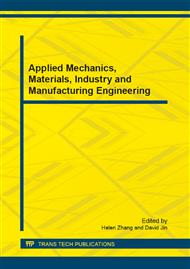[1]
Koo, S.Y., M.S. Yeo and K.W. Kim, Automated blind control to maximize the benefits of daylight in buildings., Building and Environment, vol. 45, pp.1508-1520, (2010).
DOI: 10.1016/j.buildenv.2009.12.014
Google Scholar
[2]
DAI Lei, CAI Li, Analysis on the Characteristics of Modern Urban Residence in Ningbo: A Case Study of the Residence at Daici Alley and Deji Alley in Jiangbei District, Journal of Ningbo University (Natural science & engineering edition), vol. 24, pp.128-132, (2011).
Google Scholar
[3]
J. Yao and Z. Yuan, Study on Residential Buildings with Energy Saving by 65% in Ningbo, Journal of Ningbo University (Natural science & engineering edition). vol. 23, pp.84-87, (2010).
Google Scholar
[4]
Yao, J. and N. Zhu, Evaluation of indoor thermal environmental, energy and daylighting performance of thermotropic windows., Building and Environment, vol. 49, pp.283-290, (2012).
DOI: 10.1016/j.buildenv.2011.06.004
Google Scholar
[5]
HU Xing-yun, XU Jin and ZHANG Jin-quan, Study on the Modern Rural Residence Planning with Regional Features of Fanshidu Village, Journal of Ningbo University (Natural science & engineering edition), vol. 24, pp.110-114, (2011).
Google Scholar
[6]
Yao, J. and C. Yan, Evaluation of The Energy Performance of Shading Devices based on Incremental Costs, Proceedings of World Academy of Science, Engineering and Technology, vol. 77, pp.450-452, (2011).
Google Scholar
[7]
Yao, J. and C. Yan, Effects of Solar Absorption Coefficient of External Wall on Building Energy Consumption, Proceedings of World Academy of Science, Engineering and Technology, vol. 76, pp.758-760, (2011).
Google Scholar
[8]
GAO Hua-sheng, YANG Xiao-xian and CHEN Yu –hui et al., Water Pollution Control in Rural Villages: Case Study, Journal of Ningbo University (Natural science & engineering edition), vol. 23, pp.74-78, (2010).
Google Scholar
[9]
J. Yao and N. Zhu, Enhanced Supervision Strategies for Effective Reduction of Building Energy Consumption-A Case Study of Ningbo, Energy and Buildings, vol. 43, pp.2197-2202, (2011).
DOI: 10.1016/j.enbuild.2011.04.027
Google Scholar


